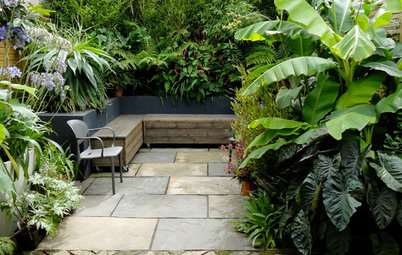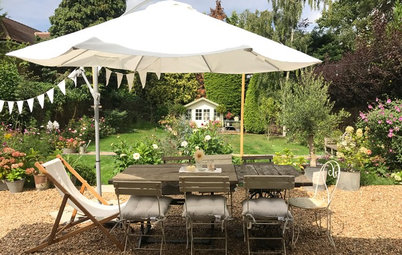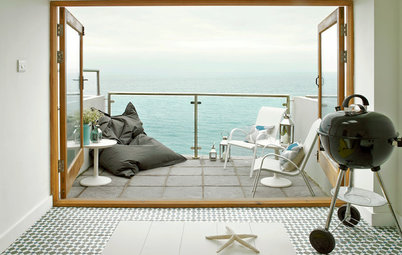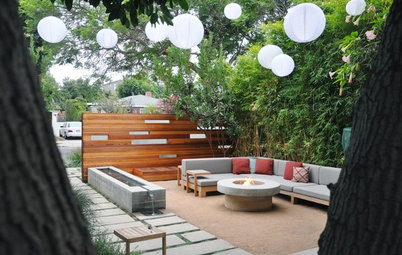How to Use One-off Special Trees to Add Wow to Your Garden
Sometimes you need just one striking tree to lift your garden out of the ordinary. Browse these ideas for what to consider and look out for
You don’t need to spend a fortune to make the best of a garden. Often, just one special tree can make or break a view, so invest wisely in the right specimen. But what do you choose? It’s easy to follow the crowd and plant the same tree as every other house, but there are lots of really special species and varieties available to create a great garden view. Don’t just think about the blossom you’ll get, but look at the year-round interest from form, foliage and fruit.
Here are some tips for choosing something special and a few species to consider for your own garden.
Here are some tips for choosing something special and a few species to consider for your own garden.
Brighten up your winter garden
In this beautiful space within a larger garden, you’d be forgiven for looking past the trees to that great terrace in the centre, but when winter comes you’d really appreciate the tree on the right.
It’s a Tibetan or mahogany cherry (Prunus serrula), which, as well as having showy white flowers in spring and great autumn tones, has the most amazing coppery-brown bark, from which it gets its common name.
Check out what to do in the garden in April
In this beautiful space within a larger garden, you’d be forgiven for looking past the trees to that great terrace in the centre, but when winter comes you’d really appreciate the tree on the right.
It’s a Tibetan or mahogany cherry (Prunus serrula), which, as well as having showy white flowers in spring and great autumn tones, has the most amazing coppery-brown bark, from which it gets its common name.
Check out what to do in the garden in April
Consider planting conifers
We tend to veer away from choosing conifers these days, but even though they’re out of fashion, they can often be the perfect choice.
This conifer succeeds in doing two things. Firstly, it punctuates the space with a vertical structure that works well on the curve of the path. Secondly, it screens the long view and therefore adds intrigue to the path, drawing you down the garden to explore further.
You could choose a conifer that gets as large as this, but there are smaller species also available, and other conifers, such as pines and cedars, can give you great year-round structural interest.
We tend to veer away from choosing conifers these days, but even though they’re out of fashion, they can often be the perfect choice.
This conifer succeeds in doing two things. Firstly, it punctuates the space with a vertical structure that works well on the curve of the path. Secondly, it screens the long view and therefore adds intrigue to the path, drawing you down the garden to explore further.
You could choose a conifer that gets as large as this, but there are smaller species also available, and other conifers, such as pines and cedars, can give you great year-round structural interest.
Frame your view
With the popularity of big bifold or sliding doors on family room extensions, you often need a great tree to frame the view from the garden back to the house.
A multi-stem specimen like this birch (Betula utilis var. jacquemontii) is a great counterbalance to that big window. The white of the trunk and the lightness of the leaf canopy makes for a particularly appealing tree.
They can get quite large, so make sure you’re balancing the potential size of the tree against the size of your home. Trees can be planted next to homes, but ask your architect or surveyor before you plant a tree next to your extension.
Browse 10 inspiring ideas for glass extensions
With the popularity of big bifold or sliding doors on family room extensions, you often need a great tree to frame the view from the garden back to the house.
A multi-stem specimen like this birch (Betula utilis var. jacquemontii) is a great counterbalance to that big window. The white of the trunk and the lightness of the leaf canopy makes for a particularly appealing tree.
They can get quite large, so make sure you’re balancing the potential size of the tree against the size of your home. Trees can be planted next to homes, but ask your architect or surveyor before you plant a tree next to your extension.
Browse 10 inspiring ideas for glass extensions
Retain what’s good in your garden
This cherry tree in a front garden was undoubtedly there before the rest of the planting and is a great specimen to give height and scale within an evergreen structure.
The planters also give vertical height, while the tree gives a horizontal structure that detracts from the large neighbouring trees. Did you notice them? No, we thought not and that’s because a simple, mid-sized tree with a great shape like this one can take your eye to it as a focal point.
This cherry tree in a front garden was undoubtedly there before the rest of the planting and is a great specimen to give height and scale within an evergreen structure.
The planters also give vertical height, while the tree gives a horizontal structure that detracts from the large neighbouring trees. Did you notice them? No, we thought not and that’s because a simple, mid-sized tree with a great shape like this one can take your eye to it as a focal point.
Research the story behind a tree
In this heritage garden, the central focus is a handkerchief or dove tree (Davidia involucrata). The tree was first brought back from China by plant hunters sent to collect its seed by a nursery that once stood on the site of this walled garden. What better reason to have a one-off tree as a focal point?
It’s a special tree, because it takes a while for it to show its ‘flowers’, which are really showy handkerchief-like leaf bracts surrounding tiny flower clusters.
In this heritage garden, the central focus is a handkerchief or dove tree (Davidia involucrata). The tree was first brought back from China by plant hunters sent to collect its seed by a nursery that once stood on the site of this walled garden. What better reason to have a one-off tree as a focal point?
It’s a special tree, because it takes a while for it to show its ‘flowers’, which are really showy handkerchief-like leaf bracts surrounding tiny flower clusters.
Add a multi-stemmed focal point
This garden is really striking from inside and, while the lighting makes it work all the better, it’s the single flowering dogwood (Cornus spp) in the foreground to the right that really makes the picture.
Dogwoods are usually defined as a tree, but you can treat them as a large shrub, with multiple stems and shaped to fit the space. In this small garden, you would need to maintain the shape of the tree through annual pruning, but that’s a small price to pay for a great specimen with year-round interest.
This garden is really striking from inside and, while the lighting makes it work all the better, it’s the single flowering dogwood (Cornus spp) in the foreground to the right that really makes the picture.
Dogwoods are usually defined as a tree, but you can treat them as a large shrub, with multiple stems and shaped to fit the space. In this small garden, you would need to maintain the shape of the tree through annual pruning, but that’s a small price to pay for a great specimen with year-round interest.
Plump for something exotic but practical
This seating area is laid out beneath the branches of a mature fig tree (Ficus carica). Its exotic leaves give a tropical feel to a garden, but in the right location it will set fruit that, given a good summer, will reward you with lots to eat and preserve.
You do need to care for fig trees by feeding them each spring, but they can cope with drought and are great for planters and pots, as they don’t mind having restricted roots. Choose a variety such as ‘Brown Turkey’ for good, reliable fruit.
This seating area is laid out beneath the branches of a mature fig tree (Ficus carica). Its exotic leaves give a tropical feel to a garden, but in the right location it will set fruit that, given a good summer, will reward you with lots to eat and preserve.
You do need to care for fig trees by feeding them each spring, but they can cope with drought and are great for planters and pots, as they don’t mind having restricted roots. Choose a variety such as ‘Brown Turkey’ for good, reliable fruit.
Capture the spirit of the Mediterranean
One tree that works brilliantly as a one-off special specimen is the olive tree (Olea europaea), with its amazing trunk and silvery-grey foliage.
Olives are surprisingly resilient trees, even during a cold UK winter. After all, they’re used to being at the whims of the wind and rain where they originate from.
An olive tree won’t work in every setting, but in this garden it reminds us of our Mediterranean holidays. It would work equally well in a dry gravel garden or in a planter on a patio. This one is quite an old tree, so you probably need to invest a little to get similar impact.
Take a tour of an English garden with a luxurious Italian mood
One tree that works brilliantly as a one-off special specimen is the olive tree (Olea europaea), with its amazing trunk and silvery-grey foliage.
Olives are surprisingly resilient trees, even during a cold UK winter. After all, they’re used to being at the whims of the wind and rain where they originate from.
An olive tree won’t work in every setting, but in this garden it reminds us of our Mediterranean holidays. It would work equally well in a dry gravel garden or in a planter on a patio. This one is quite an old tree, so you probably need to invest a little to get similar impact.
Take a tour of an English garden with a luxurious Italian mood
Create interest with a cloud-pruned tree
A touch of Japan has been added to this garden with a cloud-pruned tree. Box, yew and pine trees are most commonly used for this technique.
Trees like this are available ready-shaped, but they can be very expensive and it’s possible to create your own cloud-pruned tree with some patience and care. Surprisingly, it’s not so difficult as long as you take your time and stand back regularly to see the shape as it appears from your pruning. It might take two or three years to get the final shape you want, but it’s well worth the effort.
TELL US…
Is there a particular tree you’d recommend? Share your ideas and photos in the Comments below.
A touch of Japan has been added to this garden with a cloud-pruned tree. Box, yew and pine trees are most commonly used for this technique.
Trees like this are available ready-shaped, but they can be very expensive and it’s possible to create your own cloud-pruned tree with some patience and care. Surprisingly, it’s not so difficult as long as you take your time and stand back regularly to see the shape as it appears from your pruning. It might take two or three years to get the final shape you want, but it’s well worth the effort.
TELL US…
Is there a particular tree you’d recommend? Share your ideas and photos in the Comments below.




















Sometimes you have to be patient and give a tree time to become magnificent. This strawberry tree (Arbutus unedo) is gorgeous. You can seldom buy one as a mature specimen, but it establishes easily anywhere across Europe from the Mediterranean up to the UK.
Once established, it gives you year-round interest – an amazing structural shape, evergreen foliage, bell-shaped, white-pink flowers and strawberry-like fruits in late summer to early autumn.
This tree is probably around 30 years old, but you could achieve a good size in 10 years from a small plant.